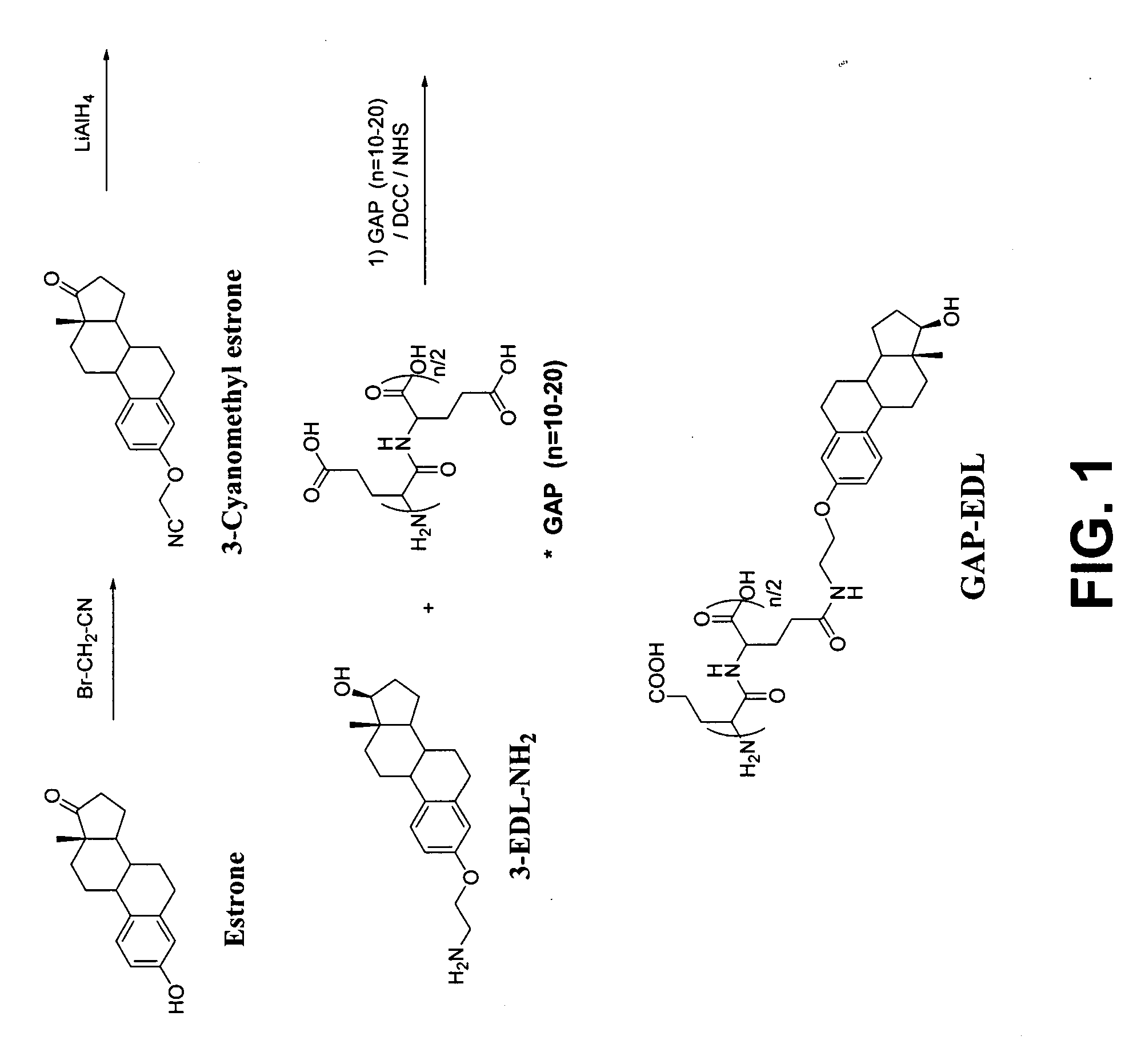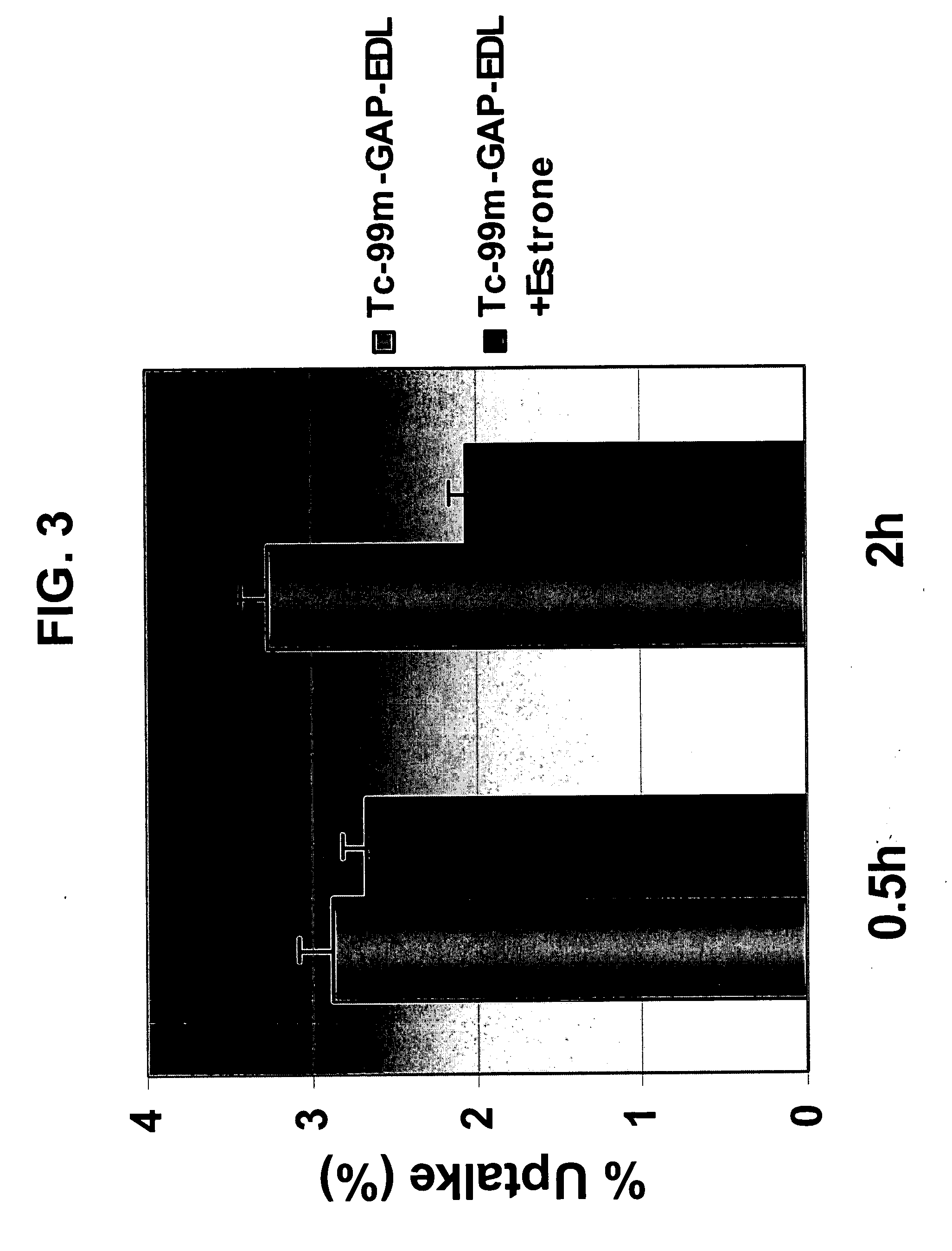Poly(peptide) as a chelator: methods of manufacture and uses
a polypeptide and chelator technology, applied in the field of polypeptide as a chelator, can solve the problems of limited imaging use of organic metals chelated in this manner, short half life of 13n]amino acids, and inability to meet the needs of general clinical application, etc., to achieve enhanced targeted imaging, prolong targeting potential, and improve water solubility
- Summary
- Abstract
- Description
- Claims
- Application Information
AI Technical Summary
Benefits of technology
Problems solved by technology
Method used
Image
Examples
example 1
99mTc-GAP-Estradiol (EDL) for Estrogen Receptor-Positive Characterization
Synthesis of 3-Aminoethyl Estradiol
[0250] Estrone (1.47 g, 5.45 mmol) was dissolved in ethanol (50 ml). NaOEt (742 mg, 10.9 mmol) and bromoacetonitrile (0.5 ml, 1.722 g / ml, 6.65 mmol) were added. The reaction mixture was heated under reflux for 24 hrs. Ethanol was evaporated to dryness and ethyl acetate was added (100 ml). The mixture was washed with water (100 ml) in a separatory funnel. The organic layer was dried over magnesium sulfate and filtered. Ethyl acetate was evaporated under reduced pressure, and the solid product was washed with ether on filter paper. The yield of 3-acetonitrile estradiol was 75%. 3-Acetonitrile estradiol (620 mg, 2 mmol) was dissolved in THF (50 ml). Lithium aluminum hydride (IM in THF) was added and the reaction mixture was stirred overnight. The solvent was evaporated and the solid was dissolved in ethyl acetate and washed with water (100 ml) in a separatory funnel. The ethyl...
example 2
99mTc-GAP-celebrex (COXi) for Cyclooxypenase-2 Characterization
Synthesis of COXi-OEt
[0264] 381.4 mg (1.0 mmol) of Celebrex (BZF, 4-[5-(4-methylphenyl)-3-(trifluoromethyl)-1-pyrazol-1-yl]-Benzenesulfonamide) and 152.4 mg (11.0 mmol) of DBU (1,8-diazabicyclo[5.4.0]undec-7-ene) were dissolved in 10 ml of chloroform. 129.1 mg (1.0 mmol) of ethyl isocyanatoacetate in 5 ml chloroform was then added dropwisely. The mixture was stirred for 3 hours at room temperature. The solvent was evaporated in vacuo and the crude product was loaded onto a silica gel packed column (mobile phase: chloroform and methanol gradient). The product (418.6 mg, white solid) was then isolated as (82% yield). Synthetic scheme of GAP-Coxi is shown in FIG. 12. Proton NMR of BZF and COXi-OEt confirmed the respective structures (FIG. 13).
Synthesis of COXi-NH2
[0265] 420.7 mg of ethylene diamine (7.0 mmol) was added into 357.4 mg (0.7 mmol) of COXi-OEt in 6 ml of ethanol. The mixture was stirred for 16 hours at roo...
example 3
99mTc-GAP-Doxorubicin (DOX) for Topoisomerase Characterization
Synthesis of GAP-DOX
[0272] 112.5 mg of GAP (Mol Wt 1500-3000) was dissolved in 10 ml of anhydrous DMF. 51.6 mg of DCC (dicyclohexylcarboimide) and 33.8 mg of DOX (Doxorubicin hydrochloride) were added and stirred overnight at room temperature. The sovent was evaporated in vacuo. 5 ml of water and 0.7 ml of 1 N-sodium hydroxide solution was then added. pH value in water layer was 7.0. The mixture was filtered with 0.8 micrometer membrane filter and dialyzed with MW CO<1,000 membrane. 139 mg of red powder (GAP-DOX, Yield 79.1%) after drying with lyophilizer was obtained.
[0273] A standard curve was established from UV observance at 485-490 nm with various doxolubicin concentrations. Composition of GAP-DOX has 72% of GAP and 28% DOX. Synthetic scheme and proton NMR are shown in FIG. 15.
In Vitro Cell Binding Affinity Studies
[0274] Two different cell lines were used for the assay—breast (13762NF) and lung cancer cell lin...
PUM
| Property | Measurement | Unit |
|---|---|---|
| β energy | aaaaa | aaaaa |
| molecular weight | aaaaa | aaaaa |
| molecular weight | aaaaa | aaaaa |
Abstract
Description
Claims
Application Information
 Login to View More
Login to View More - R&D
- Intellectual Property
- Life Sciences
- Materials
- Tech Scout
- Unparalleled Data Quality
- Higher Quality Content
- 60% Fewer Hallucinations
Browse by: Latest US Patents, China's latest patents, Technical Efficacy Thesaurus, Application Domain, Technology Topic, Popular Technical Reports.
© 2025 PatSnap. All rights reserved.Legal|Privacy policy|Modern Slavery Act Transparency Statement|Sitemap|About US| Contact US: help@patsnap.com



